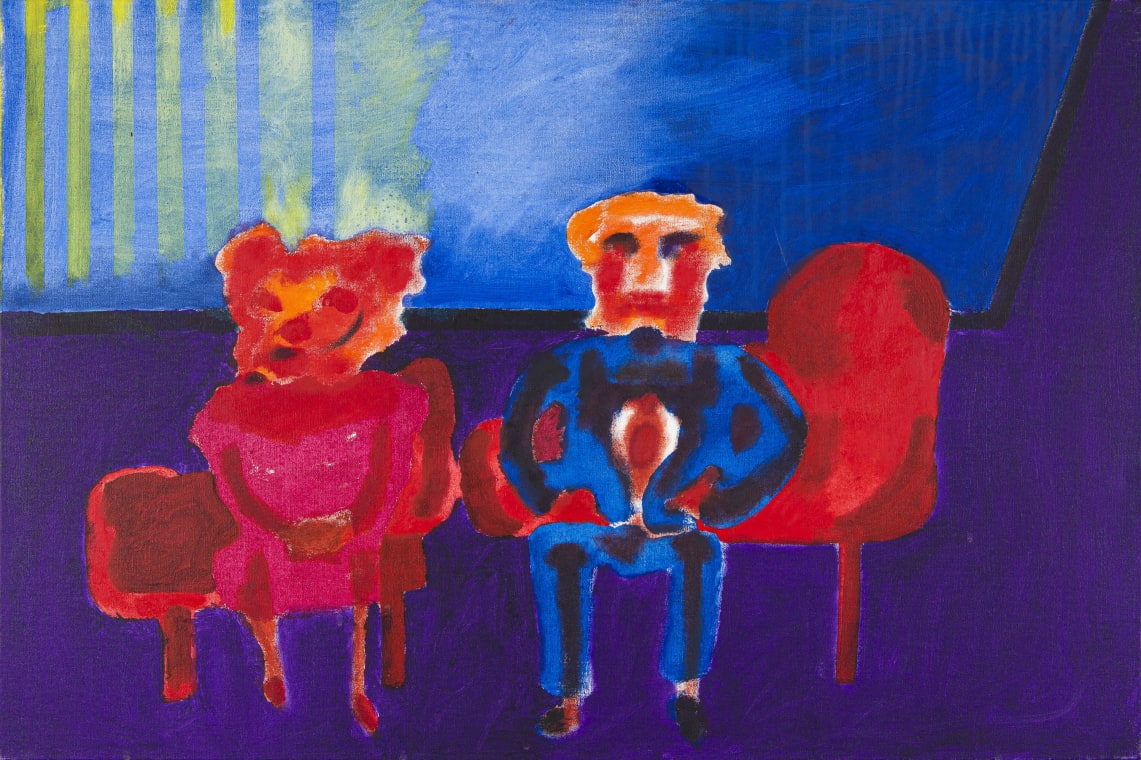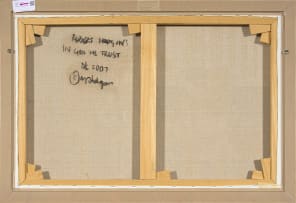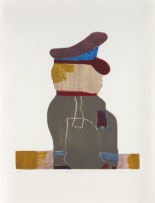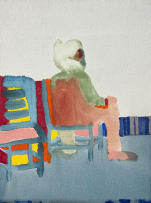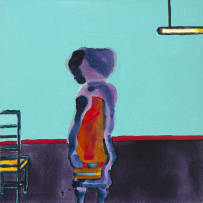Robert Hodgins
In God we Trust
About the SessionStrauss & Co is pleased to present this extraordinary collection as the featured session this September Live Virtual Auction. An established insolvency practitioner with a passion for the arts, Oliver Powell's principal focus has been collecting South African painting, sculpture and works on paper made since 1950. Colour, graphic ingenuity and emotional weight are all attributes in an artwork that Powell is drawn to. Powell also emphasises the importance of his many encounters with artists. “There is so much value in meeting an artist,” says Powell. “Aspects and details of their life are reflected in what and how they paint.”
Incl. Buyer's Premium & VAT
About this Item
signed, dated 2007 and inscribed with the title and medium on the reverse
Notes
The largest holding of work by a single artist in the Powell Collection is by Robert Hodgins. The earliest is a spare composition titled A John Webster Painting (lot 18), the titular image suggested in a central concentration of purplish colour that barely resembles a grinning skull. The title of this painting gestures to the Jacobean dramatist John Webster, who T. S. Eliot in his 1919 poem Whispers of Immortality says saw "the skull beneath the skin". Hodgins was 79, going on 80, when he produced the work. He would energetically continue painting for another decade, dying three months shy of 90. The extensive holding of works by Hodgins represent the enthusiasms of this final decade as well as provide an insight into his late style.
The prerogative of late style, wrote Edward Said in 2004, resides in "the power to render disenchantment and pleasure without resolving the contradiction between them".1 Hodgins visually navigated this tension in his late works, colourist allegories dominated by naked and costumed figures, seen at leisure and at work, and presented in their vanities and fears. The work Minor Bavarian Royalty (lot 17) maps the poles of the artist's mature interest of puncturing self-importance and rendering frailty. What distinguishes Hodgins' late style is something Said calls "mature subjectivity": it is a sensibility "stripped of hubris and pomposity, unashamed either of its fallibility or of the modest assurance it has gained as a result of age and exile."1
As is well known, Hodgins had two painting careers, the first act a brief flaring in the late 1950s. In the mid-1980s, following his retirement from teaching at Wits University, Hodgins returned to painting fulltime. Over the course of the next 15 years he worked through his many visual influences - Rouault, Grosz, Bacon, Guston, Daumier - oftentimes literally, before arriving at his settled late style. The guidance of Bacon endured, especially in the way he frontally regarded his subjects In God we Trust (lot 25) and A Fat Man in an Armchair (lot 22) and furnished his interior scenes with bands of colour and rudimentary line in Head (lot 20) and Alone in a Room (lot 21). But his liquid style of oil painting and sense for tragicomedy also greatly distinguished Hodgins from his morose English contemporary.
Some of the paintings were acquired through English dealer Simon Mee, who in 2003 installed Hodgins in a studio on Brick Lane in London's East End. Hodgins had a tough upbringing and left school early to work as an errand boy for a newsagent
in Soho. The experience revived many memories. In 2007 he painted the square canvas Soho London 1934 (lot 26) that describes the sex trade as a waiting game. Twenty Pedestrians (lot 28), while not explicitly connected to London, describes a formative event from Hodgins' youth. When not delivering newspapers twice a day or sweeping the shop, he simply stood and watched Soho going by. "At the most impressionable time of my life, without knowing it, I was being impressed."2 Many of his late paintings -teasingly rather than explicitly-rework these impressions, which travelled with Hodgins throughout his long life.
1. Edward Said (2004) 'Thoughts on Late Style', London Review of Books, Vol. 26. No. 15, 5 August: https://www.lrb.co.uk/the-paper/v26/n15/edward-said/thoughts-on-late-style
2. Sean O'Toole (2007), interview with artist, November, Pretoria.
Provenance
Simon Mee Fine Art, London, 4 August 2008.
The Oliver Powell and Timely Investments Trust Collection.
